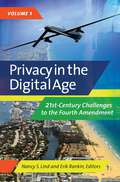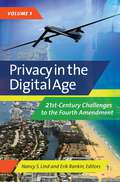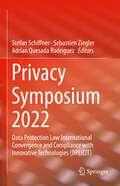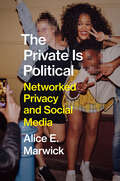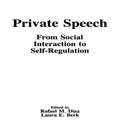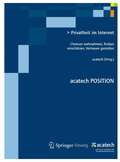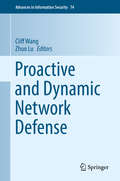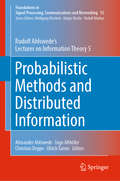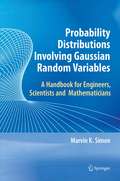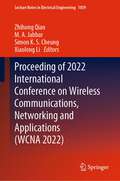- Table View
- List View
Privacy in the Digital Age [2 volumes]: 21st-Century Challenges to the Fourth Amendment [2 volumes]
by Nancy S. Lind and Erik RankinA collection of expert essays examines the privacy rights that have been lost in the post-9/11 era—giving students and others the knowledge they need to take back their constitutional protections.This timely two-volume collection shares information every citizen should have, tackling the erosion of privacy rights engendered by the ability of digital technology to intercept, mine, and store personal data, most often without the knowledge of those being monitored. Examining its subject through the lens of Fourth Amendment rights, the work focuses on technological advances that now gather personal data on an unprecedented scale, whether by monitoring social media, tracking cell phones, or using thermal imaging to watch people's movement. It also examines the possible impact of the widespread gathering of such data by law enforcement and security agencies and by private corporations such as Google.Organized by hot-button topics confronting U.S. citizens in the post-9/11 era, the work reviews the original intent of the Fourth Amendment and then traces the development and erosion of interpretations of that amendment in the 21st century. Topical essays offer a comprehensive treatment and understanding of current Fourth Amendment issues, including those that have been brought before the courts and those relative to the continuing governmental and societal emphasis on security and public safety since the Columbine shootings in 1999 and the events of September 11, 2001.
Privacy in the Digital Age [2 volumes]: 21st-Century Challenges to the Fourth Amendment [2 volumes]
A collection of expert essays examines the privacy rights that have been lost in the post-9/11 era—giving students and others the knowledge they need to take back their constitutional protections.This timely two-volume collection shares information every citizen should have, tackling the erosion of privacy rights engendered by the ability of digital technology to intercept, mine, and store personal data, most often without the knowledge of those being monitored. Examining its subject through the lens of Fourth Amendment rights, the work focuses on technological advances that now gather personal data on an unprecedented scale, whether by monitoring social media, tracking cell phones, or using thermal imaging to watch people's movement. It also examines the possible impact of the widespread gathering of such data by law enforcement and security agencies and by private corporations such as Google.Organized by hot-button topics confronting U.S. citizens in the post-9/11 era, the work reviews the original intent of the Fourth Amendment and then traces the development and erosion of interpretations of that amendment in the 21st century. Topical essays offer a comprehensive treatment and understanding of current Fourth Amendment issues, including those that have been brought before the courts and those relative to the continuing governmental and societal emphasis on security and public safety since the Columbine shootings in 1999 and the events of September 11, 2001.
Privacy Online: Perspectives on Privacy and Self-Disclosure in the Social Web
by Sabine Trepte and Leonard ReineckeCommunications and personal information that are posted online are usually accessible to a vast number of people. Yet when personal data exist online, they may be searched, reproduced and mined by advertisers, merchants, service providers or even stalkers. Many users know what may happen to their information, while at the same time they act as though their data are private or intimate. They expect their privacy will not be infringed while they willingly share personal information with the world via social network sites, blogs, and in online communities.The chapters collected by Trepte and Reinecke address questions arising from this disparity that has often been referred to as the privacy paradox. Works by renowned researchers from various disciplines including psychology, communication, sociology, and information science, offer new theoretical models on the functioning of online intimacy and public accessibility, and propose novel ideas on the how and why of online privacy. The contributing authors offer intriguing solutions for some of the most pressing issues and problems in the field of online privacy. They investigate how users abandon privacy to enhance social capital and to generate different kinds of benefits. They argue that trust and authenticity characterize the uses of social network sites. They explore how privacy needs affect users’ virtual identities. Ethical issues of privacy online are discussed as well as its gratifications and users’ concerns. The contributors of this volume focus on the privacy needs and behaviors of a variety of different groups of social media users such as young adults, older users, and genders. They also examine privacy in the context of particular online services such as social network sites, mobile internet access, online journalism, blogs, and micro-blogs.In sum, this book offers researchers and students working on issues related to internet communication not only a thorough and up-to-date treatment of online privacy and the social web. It also presents a glimpse of the future by exploring emergent issues concerning new technological applications and by suggesting theory-based research agendas that can guide inquiry beyond the current forms of social technologies.
Privacy Preservation in Distributed Systems: Algorithms and Applications (Signals and Communication Technology)
by Anqi Zhang Ping Zhao Guanglin ZhangThis book provides a discussion of privacy in the following three parts: Privacy Issues in Data Aggregation; Privacy Issues in Indoor Localization; and Privacy-Preserving Offloading in MEC. In Part 1, the book proposes LocMIA, which shifts from membership inference attacks against aggregated location data to a binary classification problem, synthesizing privacy preserving traces by enhancing the plausibility of synthetic traces with social networks. In Part 2, the book highlights Indoor Localization to propose a lightweight scheme that can protect both location privacy and data privacy of LS. In Part 3, it investigates the tradeoff between computation rate and privacy protection for task offloading a multi-user MEC system, and verifies that the proposed load balancing strategy improves the computing service capability of the MEC system. In summary, all the algorithms discussed in this book are of great significance in demonstrating the importance of privacy.
Privacy-Preserving Machine Learning for Speech Processing (Springer Theses)
by Manas A. PathakThis thesis discusses the privacy issues in speech-based applications such as biometric authentication, surveillance, and external speech processing services. Author Manas A. Pathak presents solutions for privacy-preserving speech processing applications such as speaker verification, speaker identification and speech recognition. The author also introduces some of the tools from cryptography and machine learning and current techniques for improving the efficiency and scalability of the presented solutions. Experiments with prototype implementations of the solutions for execution time and accuracy on standardized speech datasets are also included in the text. Using the framework proposed may now make it possible for a surveillance agency to listen for a known terrorist without being able to hear conversation from non-targeted, innocent civilians.
Privacy Symposium 2022: Data Protection Law International Convergence and Compliance with Innovative Technologies (DPLICIT)
by Stefan Schiffner Sebastien Ziegler Adrian Quesada RodriguezThis book presents a collection of high-quality research works and professional perspectives arising from the call for papers of the Privacy Symposium 2022; an international conference aimed towards the promotion of international dialogue, cooperation and knowledge sharing on data protection regulations, compliance and emerging technologies. Gathering legal and technology expertise, this publication provides cutting-edge perspectives on the convergence of international data protection regulations, as well as data protection compliance of emerging technologies, such as: Artificial Intelligence, e-health, blockchain, edge computing, Internet of things, V2X and Smart Grids. It includes selected papers from the Privacy Symposium conference 2022 (PSC 2022) call for papers, encompassing relevant topics, including: international law and comparative law in data protection cross-border data transfers emerging technologies and data protection compliance data protection by design technologic solutions for data protection compliance data protection good practices across industries and verticals cybersecurity and data protection assessment and certification of data protection compliance, and data subject rights implementation This publication includes papers authored by academics and professionals involved on various areas of data protection, technical, legal and compliance services.Chapter 8 and 10 are available open access under a Creative Commons Attribution 4.0 International License via link.springer.com
Privacy Symposium 2023: Data Protection Law International Convergence and Compliance with Innovative Technologies (DPLICIT)
by Stefan Schiffner Sébastien Ziegler Meiko JensenThis book presents the proceedings of the Privacy Symposium 2023. the book features a collection of high-quality research works and professional perspectives on personal data protection and emerging technologies. Gathering legal and technology expertise, it provides cutting-edge perspective on international data protection regulations convergence, as well as data protection compliance of emerging technologies, such as artificial intelligence, e-health, blockchain, edge computing, Internet of Things, V2X and smart grid. Papers encompass various topics, including international law and comparative law in data protection and compliance, cross-border data transfer, emerging technologies and data protection compliance, data protection by design, technology for compliance and data protection, data protection good practices across industries and verticals, cybersecurity and data protection, assessment and certification of data protection compliance, and data subject rights implementation.
The Private Is Political: Networked Privacy and Social Media
by Alice E. MarwickA compelling firsthand investigation of how social media and big data have amplified the close relationship between privacy and inequality Online privacy is under constant attack by social media and big data technologies. But we cannot rely on individual actions to remedy this—it is a matter of social justice. Alice E. Marwick offers a new way of understanding how privacy is jeopardized, particularly for marginalized and disadvantaged communities—including immigrants, the poor, people of color, LGBTQ+ populations, and victims of online harassment. Marwick shows that few resources or regulations for preventing personal information from spreading on the internet. Through a new theory of “networked privacy,” she reveals how current legal and technological frameworks are woefully inadequate in addressing issues of privacy—often by design. Drawing from interviews and focus groups encompassing a diverse group of Americans, Marwick shows that even heavy social media users care deeply about privacy and engage in extensive “privacy work” to protect it. But people are up against the violation machine of the modern internet. Safeguarding privacy must happen at the collective level.
Private Speech: From Social Interaction To Self-regulation
by Laura E. Berk Rafael Diaz Rafael M. DiazSince the publication of Vygotsky’s Thought and Language in the United States, a number of North American and European investigators have conducted systematic observations of children’s spontaneous private speech, giving substantial support to Vygotsky’s major hypotheses — particularly those regarding the social origins of higher psychological functions. However, there still remain many vital questions about the origins, significance, and functions of private speech: How can social and private speech be validly differentiated? What kinds of social interactions promote the use of private speech? What are the sources of individual differences in the use of private speech? This unique volume addresses these and many other important questions. Characterized by a strong emphasis on original data, it reports on systematic observations of spontaneous private speech in children and adults in both laboratory and naturalistic settings. In addition to its systematic analysis of common methodological problems in the field, the book contains the most comprehensive bibliography of the private speech literature currently available.
Private Speech: From Social Interaction To Self-regulation
by Rafael M. Diaz Laura E. BerkSince the publication of Vygotsky’s Thought and Language in the United States, a number of North American and European investigators have conducted systematic observations of children’s spontaneous private speech, giving substantial support to Vygotsky’s major hypotheses — particularly those regarding the social origins of higher psychological functions. However, there still remain many vital questions about the origins, significance, and functions of private speech: How can social and private speech be validly differentiated? What kinds of social interactions promote the use of private speech? What are the sources of individual differences in the use of private speech? This unique volume addresses these and many other important questions. Characterized by a strong emphasis on original data, it reports on systematic observations of spontaneous private speech in children and adults in both laboratory and naturalistic settings. In addition to its systematic analysis of common methodological problems in the field, the book contains the most comprehensive bibliography of the private speech literature currently available.
Privatheit im Internet: Chancen wahrnehmen, Risiken einschätzen, Vertrauen gestalten (acatech POSITION)
by AcatechMit seinen digitalen Marktplätzen, Suchmaschinen, sozialen Netzwerken und vielen anderen Diensten kann das Internet zur Verwirklichung grundlegender europäischer Werte beitragen: freie Selbstbestimmung, politische Partizipation und wirtschaftliches Wohlergehen der Menschen. Allerdings bezahlen Nutzerinnen und Nutzer Internet-Dienste häufig mit Daten statt mit Geld, wodurch ihre Privatheit infrage gestellt wird. Angesichts dieser Spannung zeigt acatech, wie eine Internet-Kultur entwickelt werden kann, die es erlaubt, die Chancen des Internets wahrzunehmen und dabei die Privatheit der Menschen schützt. Diese achatech Position enthält konkrete Handlungsempfehlungen, wie Bildung, Wirtschaft, Recht und Technik zu einer solchen Kultur beitragen können.
Privatheit im Netz: Konstruktions- und Gestaltungsstrategien von Online-Privatheit bei Jugendlichen (Medien • Kultur • Kommunikation)
by Jessica Einspanner-PflockAm Beispiel jugendlicher Online-Nutzer zeigt Jessica Einspanner-Pflock, dass Privatheit in der mediatisierten Zukunft nicht als Gegensatz, sondern als ein integraler Bestandteil digitaler Öffentlichkeit zu verstehen ist. Die Autorin entwickelt ein an der Handlungstheorie orientiertes Modell (Modell der „User Generated Privacy“), in dem die zentralen Wirkmechanismen kommunikativen, auf die Konstruktion von Privatheit in der interpersonalen Interaktion gerichteten Handelns im Social Web systematisiert werden. Die empirische Überprüfung erfolgt in einer mehrstufigen qualitativ angelegten Untersuchung am Beispiel Jugendlicher im Alter zwischen 12 und 18 Jahren und ihrer privatheitsrelevanten Facebook-Kommunikation. Die Autorin erörtert, inwiefern die sich wandelnden Strukturen öffentlicher und privater Kommunikation ein verändertes Verständnis von Privatheit hervorbringen und welche Unterschiede zwischen dem traditionellen und dem online-spezifischen Privatheitskonzept existieren.
Pro und Contra Pitch-Teilnahme: Ein Handlungsrahmen für die richtige Entscheidung (essentials)
by Lena Striegel Stefan LuppoldLena Striegel und Stefan Luppold stellen ein Modell vor, mit dessen Hilfe die Entscheidung – Pitch-Teilnahme ja oder nein – erleichtert und abgesichert wird. Relevante Kriterien fließen ein und werden in einem Gesamtkontext betrachtet, aber auch gewichtet. Analog zu einer Ampel kann das Modell bei Anfragen helfen, ein klares „Mitmachen“ zu signalisieren (grün), ein „Erfolg sehr unwahrscheinlich“ anzuzeigen (rot) oder eine Mittel-Position zu indizieren (gelb). Das auf entscheidungstheoretischen Ansätzen basierende Modell hilft bei der Strukturierung, gibt mehr Sicherheit, liefert einen Rahmen und objektiviert damit die oft rein subjektiv getroffenen Zu- bzw. Absagen. Abgerundet wird das essential durch ein Praxisbeispiel.
Proactive and Dynamic Network Defense (Advances in Information Security #74)
by Cliff Wang Zhuo LuThis book discusses and summarizes current research issues, identifies challenges, and outlines future directions for proactive and dynamic network defense. This book also presents the latest fundamental research results toward understanding proactive and dynamic network defense by top researchers in related areas. It includes research results that offer formal frameworks to define proactive and dynamic network defense, and develop novel models to analyze and evaluate proactive designs and strategies in computer systems, network systems, cyber-physical systems and wireless networks. A wide variety of scientific techniques have been highlighted to study these problems in the fundamental domain. As the convergence of our physical and digital worlds grows fast pace, protecting information systems from being tampered or unauthorized access is becoming one of the most importance issues. The traditional mechanisms of network defense are built upon a static, passive, and reactive nature, which has insufficient to defend against today's attackers that attempt to persistently analyze, probe, circumvent or fool such mechanisms. It has not yet been fully investigated to address the early stage of “cyber kill chain” when adversaries carry out sophisticated reconnaissance to plan attacks against a defense system. Recently, proactive and dynamic network defense has been proposed as an important alternative towards comprehensive network defense. Two representative types of such defense are moving target defense (MTD) and deception-based techniques. These emerging approaches show great promise to proactively disrupt the cyber-attack kill chain and are increasingly gaining interest within both academia and industry. However, these approaches are still in their preliminary design stage. Despite the promising potential, there are research issues yet to be solved regarding the effectiveness, efficiency, costs and usability of such approaches. In addition, it is also necessary to identify future research directions and challenges, which is an essential step towards fully embracing proactive and dynamic network defense. This book will serve as a great introduction for advanced-level computer science and engineering students who would like to start R&D efforts in the field of proactive and dynamic network defense. Researchers and professionals who work in this related field will also find this book useful as a reference.
Probabilistic Methods and Distributed Information: Rudolf Ahlswede’s Lectures on Information Theory 5 (Foundations in Signal Processing, Communications and Networking #15)
by Rudolf Ahlswede Alexander Ahlswede Ingo Althöfer Christian Deppe Vladimir Blinovsky Ulrich Tamm Holger Boche Ulrich Krengel Ahmed MansourThe fifth volume of Rudolf Ahlswede’s lectures on Information Theory focuses on several problems that were at the heart of a lot of his research. One of the highlights of the entire lecture note series is surely Part I of this volume on arbitrarily varying channels (AVC), a subject in which Ahlswede was probably the world's leading expert. Appended to Part I is a survey by Holger Boche and Ahmed Mansour on recent results concerning AVC and arbitrarily varying wiretap channels (AVWC). After a short Part II on continuous data compression, Part III, the longest part of the book, is devoted to distributed information. This Part includes discussions on a variety of related topics; among them let us emphasize two which are famously associated with Ahlswede: "multiple descriptions", on which he produced some of the best research worldwide, and "network coding", which had Ahlswede among the authors of its pioneering paper. The final Part IV on "Statistical Inference under Communication constraints" is mainly based on Ahlswede’s joint paper with Imre Csiszar, which received the Best Paper Award of the IEEE Information Theory Society. The lectures presented in this work, which consists of 10 volumes, are suitable for graduate students in Mathematics, and also for those working in Theoretical Computer Science, Physics, and Electrical Engineering with a background in basic Mathematics. The lectures can be used either as the basis for courses or to supplement them in many ways. Ph.D. students will also find research problems, often with conjectures, that offer potential subjects for a thesis. More advanced researchers may find questions which form the basis of entire research programs.
Probabilistic-Statistical Approaches to the Prediction of Aircraft Navigation Systems Condition (Springer Aerospace Technology)
by Eliseev B. P. Kozlov A. I. Romancheva N. I. Shatrakov Y. G. Zatuchny D. A. Zavalishin O. I.This book highlights the development of new methods for assessing and forecasting the state of various complex ageing systems in service; analyzing the influence of destabilizing factors on the accuracy of aircraft flight navigation support; and making recommendations on the ideal aircraft route, taking into consideration the available information on the reliability of the navigation and communication equipment.
Probability Distributions Involving Gaussian Random Variables: A Handbook for Engineers and Scientists
by Marvin K. SimonThis handbook, now available in paperback, brings together a comprehensive collection of mathematical material in one location. It also offers a variety of new results interpreted in a form that is particularly useful to engineers, scientists, and applied mathematicians. The handbook is not specific to fixed research areas, but rather it has a generic flavor that can be applied by anyone working with probabilistic and stochastic analysis and modeling. Classic results are presented in their final form without derivation or discussion, allowing for much material to be condensed into one volume.
Probability in Electrical Engineering and Computer Science: An Application-Driven Course
by Jean WalrandThis revised textbook motivates and illustrates the techniques of applied probability by applications in electrical engineering and computer science (EECS). The author presents information processing and communication systems that use algorithms based on probabilistic models and techniques, including web searches, digital links, speech recognition, GPS, route planning, recommendation systems, classification, and estimation. He then explains how these applications work and, along the way, provides the readers with the understanding of the key concepts and methods of applied probability. Python labs enable the readers to experiment and consolidate their understanding. The book includes homework, solutions, and Jupyter notebooks. This edition includes new topics such as Boosting, Multi-armed bandits, statistical tests, social networks, queuing networks, and neural networks. For ancillaries related to this book, including examples of Python demos and also Python labs used in Berkeley, please email Mary James at mary.james@springer.com. This is an open access book.
Probability, Random Processes, and Ergodic Properties
by Robert M. GrayProbability, Random Processes, and Ergodic Properties is for mathematically inclined information/communication theorists and people working in signal processing. It will also interest those working with random or stochastic processes, including mathematicians, statisticians, and economists. Highlights: Complete tour of book and guidelines for use given in Introduction, so readers can see at a glance the topics of interest. Structures mathematics for an engineering audience, with emphasis on engineering applications. New in the Second Edition: Much of the material has been rearranged and revised for pedagogical reasons. The original first chapter has been split in order to allow a more thorough treatment of basic probability before tackling random processes and dynamical systems. The final chapter has been broken into two pieces to provide separate emphasis on process metrics and the ergodic decomposition of affine functionals. Many classic inequalities are now incorporated into the text, along with proofs; and many citations have been added.
Probability, Random Processes, and Ergodic Properties
by Robert M. GrayThis book has been written for several reasons, not all of which are academic. This material was for many years the first half of a book in progress on information and ergodic theory. The intent was and is to provide a reasonably self-contained advanced treatment of measure theory, prob ability theory, and the theory of discrete time random processes with an emphasis on general alphabets and on ergodic and stationary properties of random processes that might be neither ergodic nor stationary. The intended audience was mathematically inc1ined engineering graduate students and visiting scholars who had not had formal courses in measure theoretic probability . Much of the material is familiar stuff for mathematicians, but many of the topics and results have not previously appeared in books. The original project grew too large and the first part contained much that would likely bore mathematicians and dis courage them from the second part. Hence I finally followed the suggestion to separate the material and split the project in two. The original justification for the present manuscript was the pragmatic one that it would be a shame to waste all the effort thus far expended. A more idealistic motivation was that the presentation bad merit as filling a unique, albeit smaIl, hole in the literature.
Probability, Random Variables, and Data Analytics with Engineering Applications
by P. Mohana ShankarThis book bridges the gap between theory and applications that currently exist in undergraduate engineering probability textbooks. It offers examples and exercises using data (sets) in addition to traditional analytical and conceptual ones. Conceptual topics such as one and two random variables, transformations, etc. are presented with a focus on applications. Data analytics related portions of the book offer detailed coverage of receiver operating characteristics curves, parametric and nonparametric hypothesis testing, bootstrapping, performance analysis of machine vision and clinical diagnostic systems, and so on. With Excel spreadsheets of data provided, the book offers a balanced mix of traditional topics and data analytics expanding the scope, diversity, and applications of engineering probability. This makes the contents of the book relevant to current and future applications students are likely to encounter in their endeavors after completion of their studies. A full suite of classroom material is included. A solutions manual is available for instructors. Bridges the gap between conceptual topics and data analytics through appropriate examples and exercises; Features 100's of exercises comprising of traditional analytical ones and others based on data sets relevant to machine vision, machine learning and medical diagnostics;Intersperses analytical approaches with computational ones, providing two-level verifications of a majority of examples and exercises.
Problem Questions for Law Students: A Study Guide
by Geraint BrownLaw students rarely have experience answering problem questions before university, and lecturers concentrate on teaching content rather than the exam skills needed. This book bridges the gap on how to transpose knowledge and research into structured and coherent answers to problem questions while earning a law degree. Aimed at undergraduates, international students, and foundation and SQE candidates, the book gives a step-by-step study guide on how to navigate what a problem question is asking you to do. It deconstructs the process using examples from a range of different fields of law, providing essential guidance from research and critical thinking to style and tone. Including a range of examples to test yourself against, this is an indispensable resource for any law student who wants to tackle problem questions with confidence.
Problem Questions for Law Students: A Study Guide
by Geraint BrownLaw students rarely have experience answering problem questions before university, and lecturers concentrate on teaching content rather than the exam skills needed. This book bridges the gap on how to transpose knowledge and research into structured and coherent answers to problem questions while earning a law degree. Aimed at undergraduates, international students, and foundation and SQE candidates, the book gives a step-by-step study guide on how to navigate what a problem question is asking you to do. It deconstructs the process using examples from a range of different fields of law, providing essential guidance from research and critical thinking to style and tone. Including a range of examples to test yourself against, this is an indispensable resource for any law student who wants to tackle problem questions with confidence.
Proceeding of 2021 International Conference on Wireless Communications, Networking and Applications (Lecture Notes in Electrical Engineering)
by Zhihong Qian M. A. Jabbar Xiaolong LiThis open access proceedings includes original, unpublished, peer-reviewed research papers from the International Conference on Wireless Communications, Networking and Applications (WCNA2021), held in Berlin, Germany on December 17-19th, 2021. The topics covered include but are not limited to wireless communications, networking and applications.The papers showcased here share the latest findings on methodologies, algorithms and applications in communication and network, making the book a valuable asset for professors, researchers, engineers, and university students alike.This is an open access book.
Proceeding of 2022 International Conference on Wireless Communications, Networking and Applications (Lecture Notes in Electrical Engineering #1059)
by Xiaolong Li Simon K. S. Cheung M. A. Jabbar Zhihong QianThis proceedings includes original, unpublished, peer-reviewed research papers from the International Conference on Wireless Communications, Networking and Applications (WCNA2022), held in Wuhan, Hubei, China, from December 16 to 18, 2022. The topics covered include but are not limited to wireless communications, networking and applications.The papers showcased here share the latest findings on methodologies, algorithms and applications in communication and network, making the book a valuable asset for professors, researchers, engineers, and university students alike.
